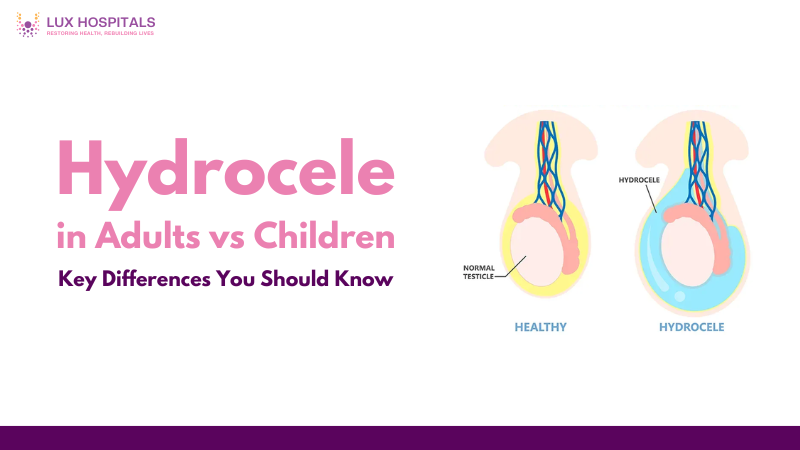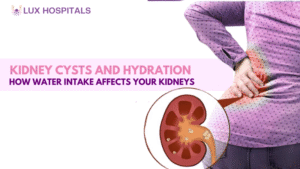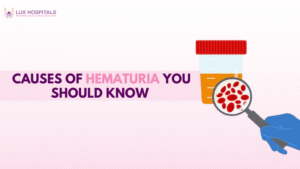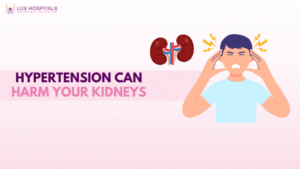Hydrocele in Adults vs. Children: Key Differences, Causes and Treatments

A frequent hydrocele disorder is defined by a fluid buildup in the scrotum, particularly in the area surrounding the testicle. Although it can happen at any age, children and adults have different underlying causes, symptoms, treatment modalities, and implications. Understanding these differences is imperative for prompt diagnosis, suitable treatment, and the best results. This article will examine these distinctions in great detail to give readers a thorough grasp.
What is a hydrocele?
A hydrocele is a sac filled with serous fluid that develops around a testicle, causing the scrotum to swell. Both unilateral and bilateral occurrences are possible and are typically not painful. However, it can lead to discomfort and aesthetic concerns. Hydroceles are classified into two main types: communicating and non-communicating. Communicating hydroceles connect with the abdominal cavity, while non-communicating hydroceles are isolated. The patient’s age and the cause of the ailment play a significant role in the classification. Hydroceles can be congenital (present at birth) or acquired later in life due to various causes.
Key Differences Between Hydrocele in Adults and Children
1. Causes
In Children:
- Pediatric hydroceles are mostly congenital and result from the failure of the process us vaginalis to close after the testicles descend during fetal development.
- This failure creates a channel between the abdominal cavity and scrotum, allowing peritoneal fluid to flow into the scrotum.
- These are often classified as communicating hydroceles and can change in size depending on the child’s position or activity.
- Some cases may be associated with an inguinal hernia, which can increase the risk of complications and requires surgical attention.
In Adults:
- Adult hydroceles are typically acquired and often stem from underlying inflammatory or traumatic causes.
- Common causes include epididymitis, orchitis, testicular torsion, injury, surgery, or tumors.
- The exact cause remains idiopathic in many cases, meaning it cannot be definitively identified.
- Non-communicating hydroceles are more common in adults, as they are sealed off from the abdominal cavity.
2. Symptoms
In Children:
- The primary symptom is painless swelling in one or both sides of the scrotum, which may be more prominent at certain times of the day.
- Swelling may fluctuate in size, especially in communicating hydroceles, due to changes in abdominal pressure.
- Most children do not exhibit signs of discomfort or systemic illness.
- Parents often discover hydroceles during diaper changes or bathing.
In Adults:
- Adult hydroceles also present as scrotal swelling but may be associated with a heaviness or dragging sensation.
- Discomfort can increase with prolonged standing or physical activity.
- Pain or tenderness may occur in some cases, mainly if an underlying infection or inflammation occurs.
- Severe swelling can interfere with daily activities or sexual function, prompting medical consultation.
3. Diagnosis
- Diagnosis typically begins with a physical examination by a healthcare provider.
- Transillumination—shining a light through the scrotum—is a key diagnostic tool. A hydrocele usually allows light to pass through.
- Ultrasound imaging is the gold standard, especially in adults, to rule out hernias, testicular cancer, or other abnormalities.
- A detailed history and physical exam are often sufficient in children unless the hydrocele persists or complications are suspected.
4. Treatment Options
In Children:
- Most pediatric hydroceles resolve spontaneously by 12 to 24 months of age.
- If a hydrocele persists beyond two years, increases in size, or is associated with a hernia, surgical correction (hydrocelectomy) is advised.
- Surgery is typically safe and quick, performed under general anesthesia, with minimal risk of complications.
- Postoperative recovery is usually smooth, and recurrence is rare
In Adults:
- For asymptomatic or small hydroceles, observation may be appropriate.
- Persistent, significant, or painful hydroceles often require hydrocelectomy, in which the fluid is drained and the sac removed.
- Aspiration and sclerotherapy may be used in some cases, particularly for patients who cannot undergo surgery. However, these methods have a higher recurrence rate.
- When performed by an experienced urologist, surgical treatment has a high success rate and a low risk of complications.
5. Complications
In Children:
- While complications are rare, untreated communicating hydroceles can lead to inguinal hernias, which may become incarcerated.
- Large hydroceles can cause discomfort or mobility issues in some cases.
- Prompt surgical management prevents long-term issues.
In Adults:
- Possible complications include infection, scrotal discomfort, and pressure-related testicular damage.
- Long-term or significant hydroceles can lead to testicular atrophy.
- Though uncommon, hydroceles can mask underlying testicular tumors.
6. Prognosis
- The overall prognosis for hydrocele is excellent, especially with timely treatment.
- Children generally recover completely without long-term consequences.
- Adults also do well, though those with underlying causes such as infection or tumors may require additional treatment.
- Early detection and appropriate management are key to avoiding complications and ensuring a full recovery.
Conclusion
Although hydrocele may seem straightforward, managing it effectively requires an awareness of how it manifests differently in adults and children. While adult hydroceles necessitate additional research and possible treatment, pediatric hydroceles are usually congenital and self-limiting. Hydrocele is a very manageable illness with excellent long-term results when appropriately treated.
If you or your child experiences scrotal swelling, consult a healthcare professional for a thorough evaluation and personalized treatment plan. Early attention can prevent complications and provide peace of mind.
Frequently Asked Questions
While hydroceles in adults are usually benign, they can become uncomfortable or indicate more serious conditions. If associated with infection, trauma, or tumors, prompt treatment is essential. Ignoring symptoms may result in complications such as testicular damage or fertility issues.
Adult hydroceles generally do not resolve without treatment. Some may improve if related to a temporary condition like an infection. However, persistent hydroceles usually require surgical intervention, especially if they cause discomfort or grow in size over time.
Hydroceles in children are usually congenital and self-resolving. Unlike adults, pediatric hydroceles often resolve naturally within the first two years of life. Communicating hydroceles, however, may persist or lead to hernias and require surgical correction.
You should seek medical attention if the hydrocele is painful, increases in size rapidly, or causes discomfort. Any signs of redness, fever, or hard lumps also warrant immediate evaluation. Early diagnosis helps rule out severe conditions and enables timely treatment.
In most cases, hydroceles do not impact fertility. However, very large hydroceles or those associated with infections may impair sperm production or testicular function. If fertility is a concern, especially in adults, a urologist should be consulted.
The surgical procedure to correct a hydrocele is known as hydrocelectomy. It involves removing or repairing the sac that holds the fluid. The surgery is effective and minimally invasive, typically allowing full recovery within a few weeks.




















